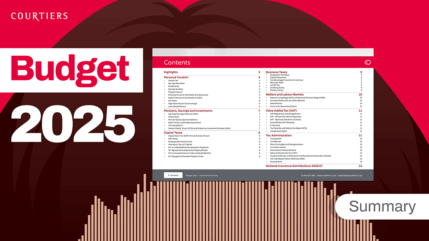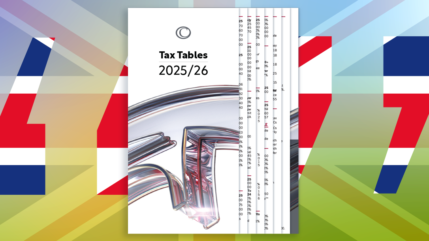Many people are aware of the annual ISA allowance, but the annual Capital Gains Tax allowance (or CGT allowance) is something often overlooked and underutilised.
Key Takeaway:
It’s essential to review and utilise your CGT allowance annually. If left unused over the course of a tax year, you lose it!
With planning and action, you could make beneficial use of your CGT allowance, in turn protecting your wealth and securing yourself (and any loved ones) a more rewarding financial future.
Available for everyone, but inevitably not everyone…
CGT receipts are forecast to reach £9.1 billion in 2019-20, and some investors could get caught in the CGT crosshairs if they don’t tread carefully. Others might even lose this valuable allowance altogether.

Annual opportunity
As we approach the end of another tax year, a crucial bona fide tax planning strategy Courtiers employs for clients holding collective investment portfolios involves rebasing the portfolio, by realising gains up to the limit of the client’s available CGT allowance. By doing this on an annual basis where gains and the annual allowance permit, the gains on the portfolio can be partially reset each year. To some extent, this controls the capital gains liability for future years.
You might be wondering how all this works in practice, in which case read on…
Investments held within non-ISA or non-pension wrappers tend to be less tax efficient and . By being mindful and actively managing other investment wrappers (for example collective portfolios), you could take advantage of the hugely beneficial tax savings with the support of your Courtiers Adviser. For a summary of Capital Gains Tax, please refer to my colleague Josh’s recent article: Utilising Your Capital Gains Tax Allowance.

Time to rise.
Historically, a simplistic way of maximising CGT allowance would be to use a method known as Bed & Breakfast, where you sell the investments on one trading day, crystallise the gain, then repurchase those same investments during the subsequent trading day. This would take place either side of the tax year.
In 1998, matching rules came into effect. These put an end to Bed & Breakfasting, by stipulating the condition of 30 days needing to pass by before being able to repurchase those same investments on the 31st day. This presents a slight problem, since there’s some probability that the market could experience an upswing in performance over the 30-day period while your money’s out, thereby disadvantaging the investor. Of course, the contrary is also true in light of a market downturn.
Sidestepping the issues presented by the 30-day window is best explained with an example:
- Client X has a collective investment portfolio with Courtiers valued at £200,000. This is currently invested within the Total Return Balanced Risk Fund, in line with their average risk profile.
- Approaching the end of the 2019-20 tax year, unrealised gains on the portfolio since the beginning of the 2019-20 tax year amount to £20,000, with Client X also having a full £12,000 CGT allowance still available.
- In percentage terms, the CGT allowance as a proportion of the total unrealised gain (£12,000 / £20,000), i.e. 60%, is the amount of the portfolio which can be sold (£120,000), to ensure that the gain realised does not breach the investors available CGT allowance for the 2019-20 tax year.
- A sale of £120,000 from the Total Return Balanced fund takes place, thereby crystallising the £12,000 gain.
- It happens to be that Client X also has a Courtiers stocks and shares ISA, with a remaining ISA allowance of £10,000 for the 2019-20 tax year. Courtiers will seek to help Client X maximise their ISA allowance before the end of the 2019-20 tax year, ensuring that their funds continue to grow in a tax efficient manner.
- £10,000 of the £120,000 is invested into Client X’s ISA, leaving the remaining £110,000 to be invested into alternative Courtiers funds suitable to meet Mr X’s average attitude to risk, calculated using sophisticated modelling systems and techniques. This could for example be a purchase of the Courtiers Total Return Growth Fund at 40%, and the Total Return Cautious Risk Fund at 60%. Fundamentally, Client X’s funds remain appropriately invested in the markets.
- On day 31, and now into the 2020-21 tax year, Courtiers could then sell the full amounts contained within the Growth and Cautious funds, which may be more or less than £110,000 depending on market performance over the 30-day period, whilst seeking to utilise Client X’s 2020-21 ISA allowance, assuming to be unchanged at £20,000.
- After topping up the client’s ISA by the full £20,000, the remaining £90,000 can be reinvested into the original Courtiers Total Return Balanced Risk Fund, still within the collective investment portfolio.
The above action and variances of this example have the effect of rebalancing our clients’ capital gains positions on such portfolios. We help individuals and families maximise valuable HMRC tax allowances to benefit their financial futures, through an opportunity easily lost if not monitored.

Go carefully
In practice, due to a mismatch in timing between the instruction given to trade and the close of various markets on a given day, prices can in fact move upwards and could impact on the capital gain, by breaching the CGT allowance. To mitigate the risk of breaching a client’s CGT limit for 2019-20, it is down to the discretion of the adviser, who will target the capital gain as close to your CGT allowance as possible, by managing how much of the portfolio is sold, whilst accounting for a possible uptick in performance.
Of course, before this exercise is carried out, the adviser will liaise with the client to establish whether they have realised any gains on other investments they hold, in order to take this into consideration when realising gains on the client’s portfolio. At the end of each tax year, Courtiers will issue its clients with a consolidated tax certificate comprising a full summary of the trades effected and gains realised, for any tax return requirements.
In the event of poor market performance producing capital losses, the above strategy can still be implemented, followed by the topping up of any unused ISA allowances. These capital losses are realised by selling out of the collective investment portfolio, crystallising the loss. If registered with HMRC, any unused capital losses can then be carried forward indefinitely, to be offset against any future gains on the portfolio or against other investments subject to CGT.

Hopefully, there’s some value here in helping you identify any CGT opportunities you might have available. Similarly, this insight demonstrates just one way Courtiers helps many clients establish and achieve realistic financial goals.
You might like to talk with us about CGT so we can understand where you are and explore any opportunities specific to you. We’re always happy to talk over the phone or host an initial meeting (with no obligation on your part) to establish whether we can help.













